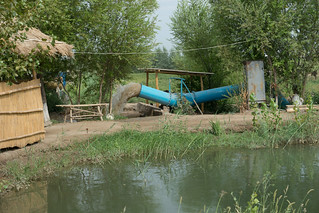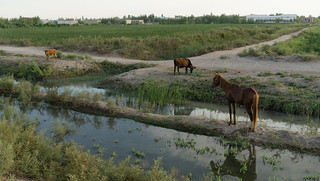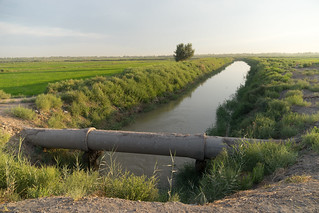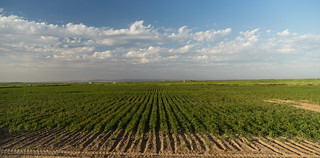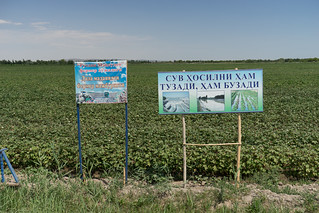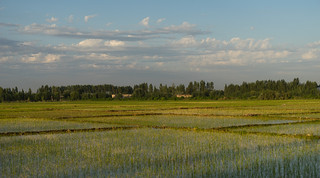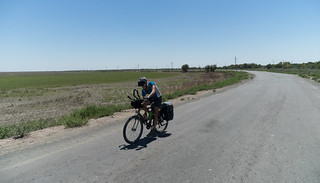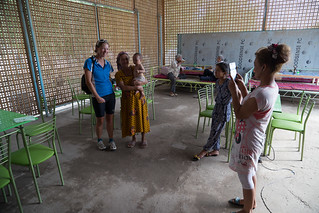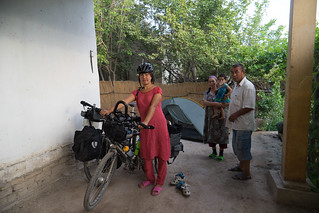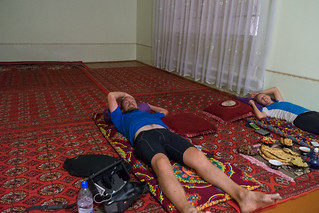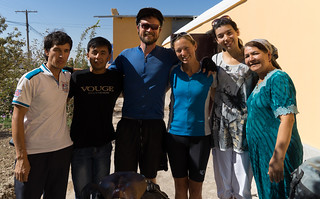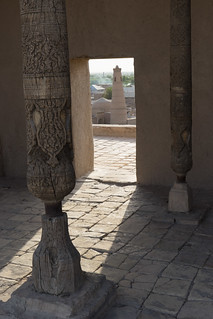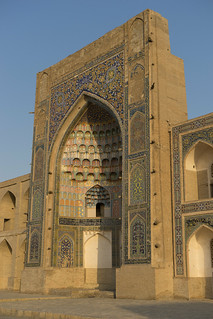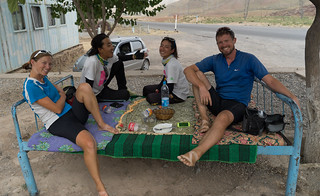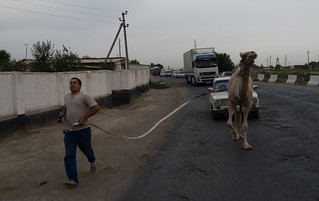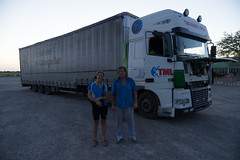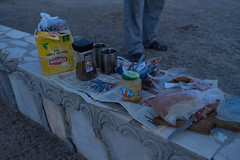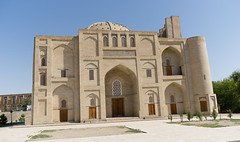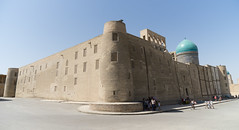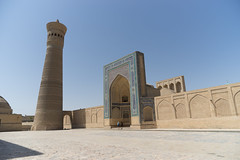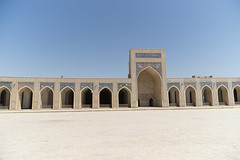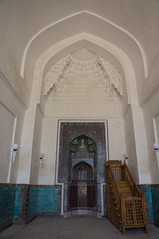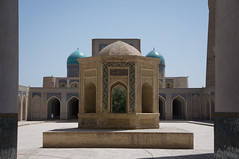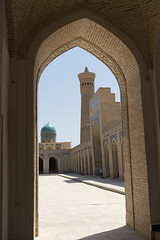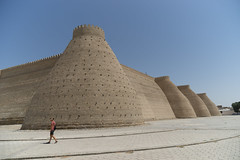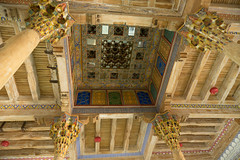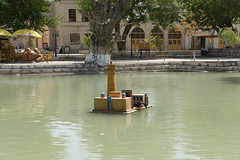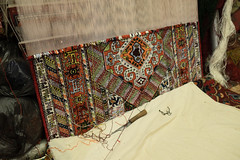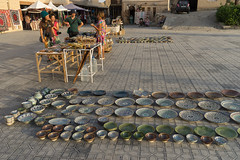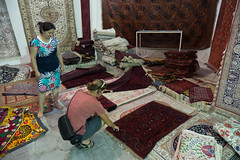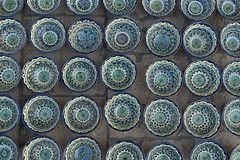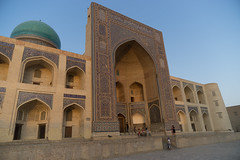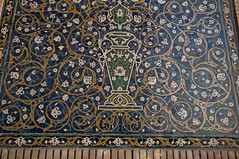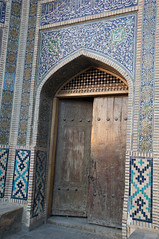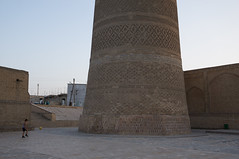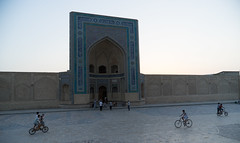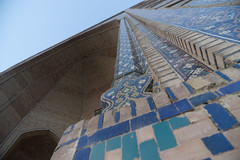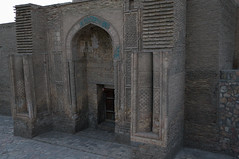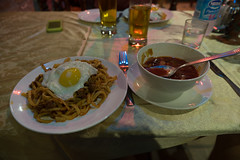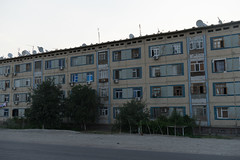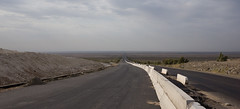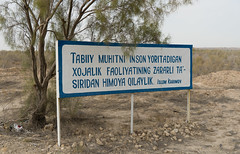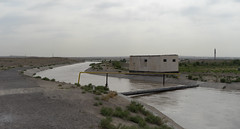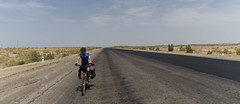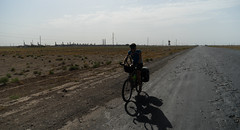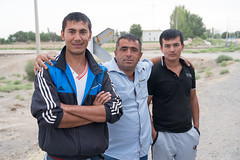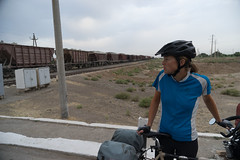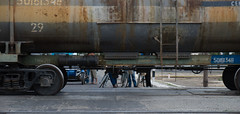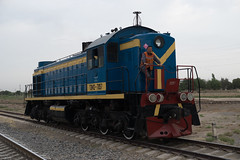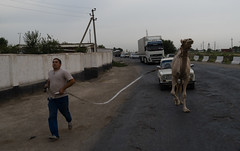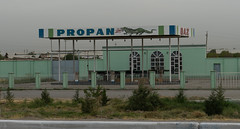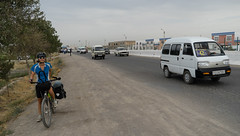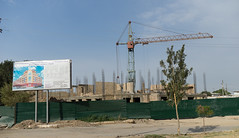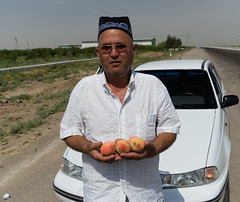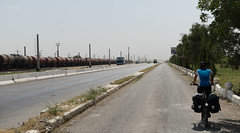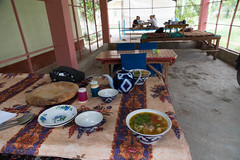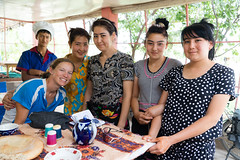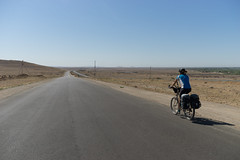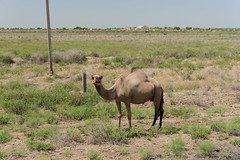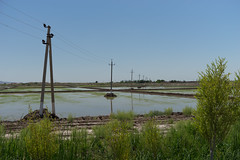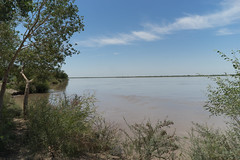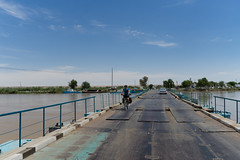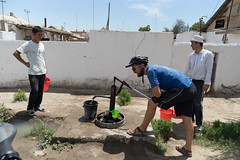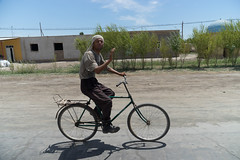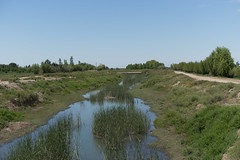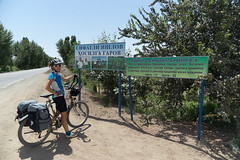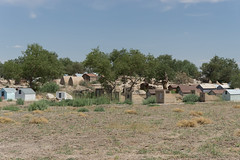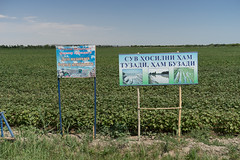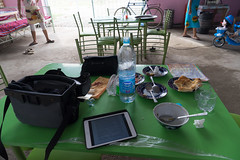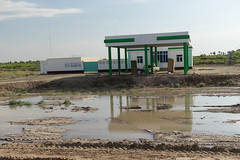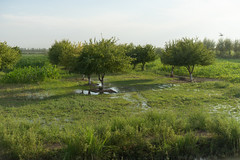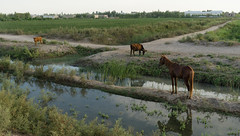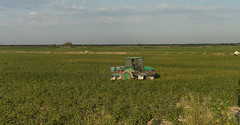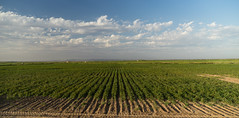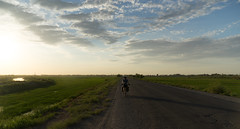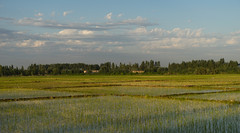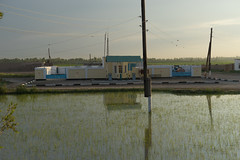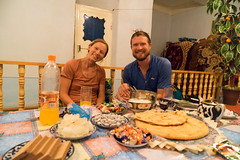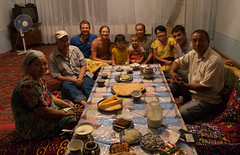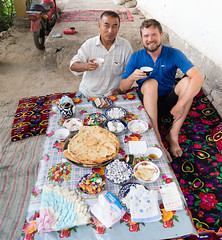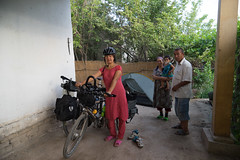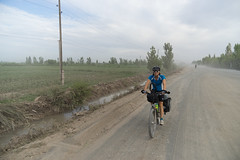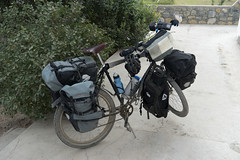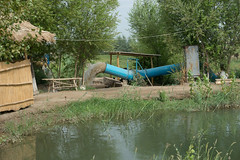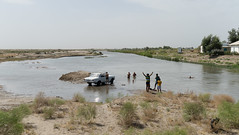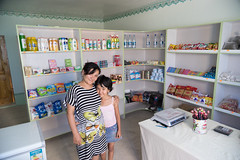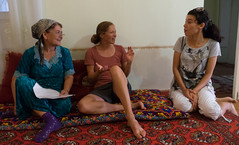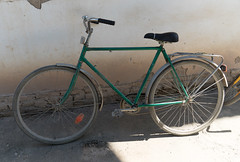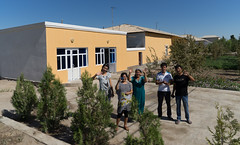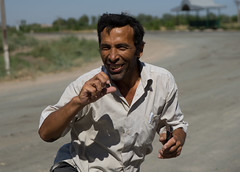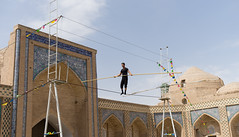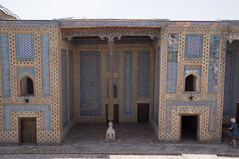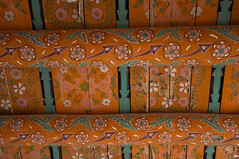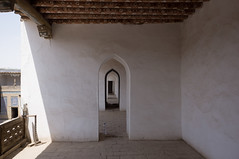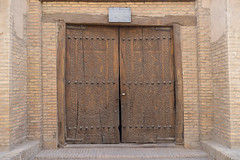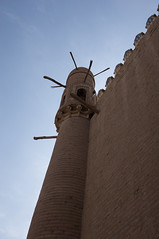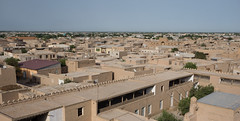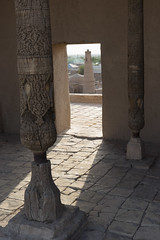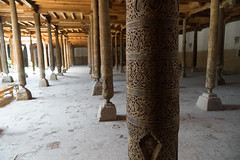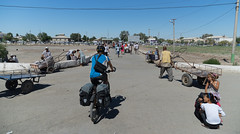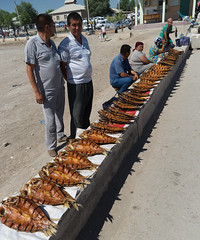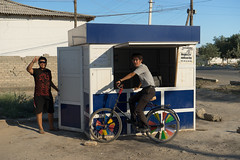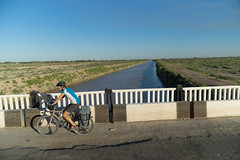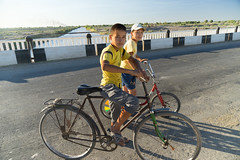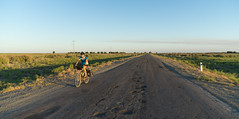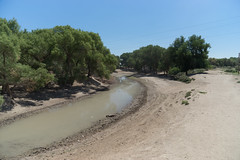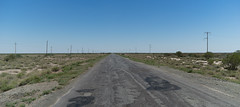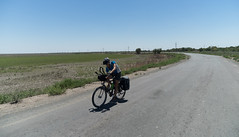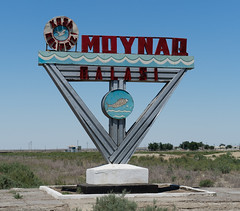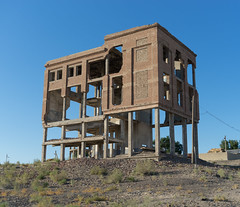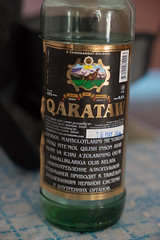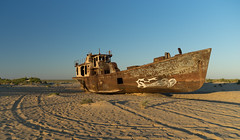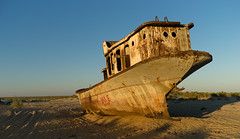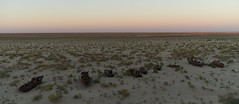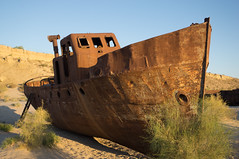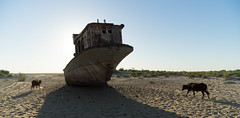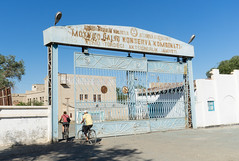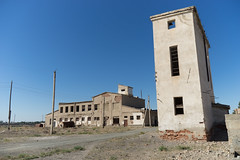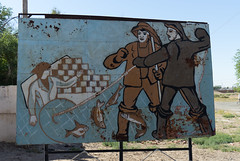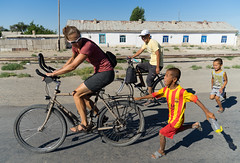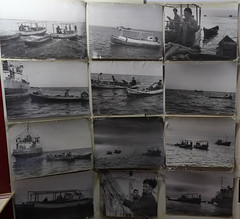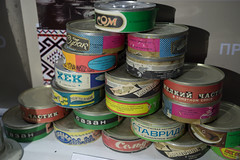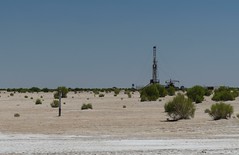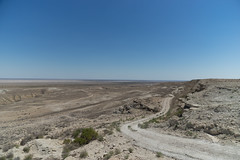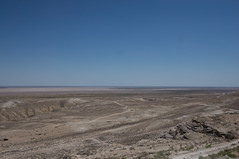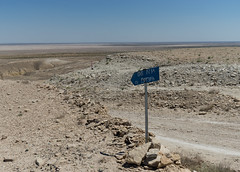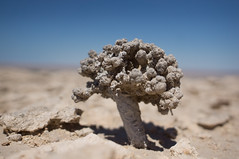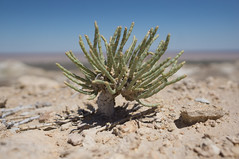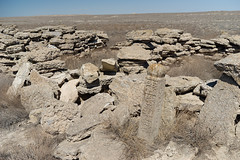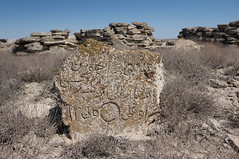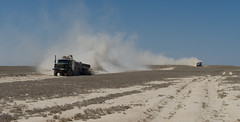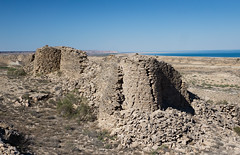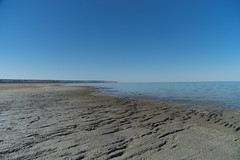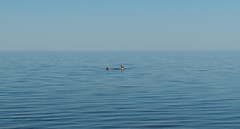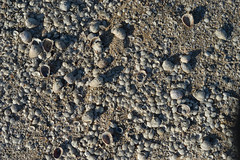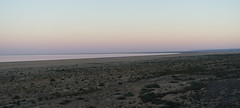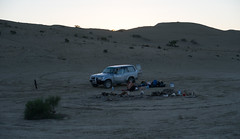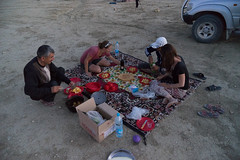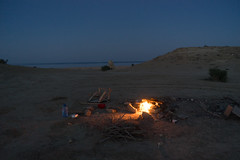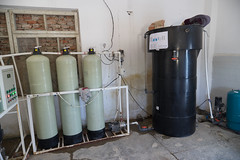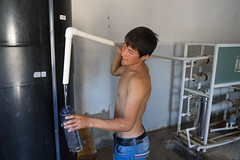After visiting the Aral Sea and learning about the impacts of its near-disappearance, we decided to travel along the Amu Darya, one of its two former sources, in order to learn a bit about where all the water goes now.
In Nukus, about 200 km south of Muynak – the town that used to be on the shore of the Aral Sea – we met with Izzet, a civil engineer who works as a professor in Nukus and helps run an NGO dedicated to protecting the Aral Sea. Then we biked another 200 km along the Amu Darya to Urgench, via the ancient Silk Road city of Khiva, and met with Inna Rudenko, who helped form and now manages a group of academics doing research and outreach to improve land and water management in the region. From these two meetings, we learned about some of the major problems with water and land use in Uzbekistan, as well as potential solutions. (Of course, in such a short time we were only able to scratch the surface of this complex issue, and there is much more to learn.) As we biked, we also observed a stark contrast to the former Aral Sea shore. While Muynak was parched and dusty, the towns we passed through between Nukus and Urgench were lush and green. The streets were lined with cotton and rice fields with water ponding between the rows, and each home we visited had a large garden with small canals running through them. It was cooler – though still scorchingly hot – near the canals, and leaky pipes spraying water into the air were everywhere.
As is the case anywhere in the world, land use and water management are tightly linked. In Uzbekistan, water management and agricultural practices follow the patterns established by the Soviet Union, which collectivized farms and set quotas for major crops such as cotton. While water from the Amu Darya had been used for centuries for irrigation, diversions increased dramatically as the Soviet Union turned Central Asia – especially Uzbekistan, south Kazakhstan, and parts of Tajikistan – into a major cotton-producing center. Irrigation is generally done by canal and relies on gravity to distribute water to and across each field. These canals are very rarely lined, and up to 40% of irrigation water is lost to the water table due to infiltration.
In addition to the water used to irrigate crops during the growing season, farmers ‘flush’ their fields several times each year before planting.This involves sending water across the empty fields to pick up salts and toxins in the soil and carry them away. While most fields require this, it is rare for a farmer to know just how contaminated his field is, and therefore how much water is actually needed to effectively remove the toxins. Therefore, many farmers will use as much water as is available, sometimes flushing their fields up to three times. This causes an enormous amount of water waste and water pollution, and until recently also had the effect of routing toxins back to the canals and downstream, as the water used in flushing would be returned directly to the canals at the other end of the field. In the past several years, a World Bank project has built a sewer system to collect the wastewater and keep it separate from the canals that feed downstream fields. Instead, the water ends up in lakes constructed in the desert for this purpose. Apparently people fish in these lakes, and the concentration of salts and agricultural chemicals isn’t dangerously high, but I have trouble believing this.
Taking a step back, we see that this inefficient water use is just part of a much bigger problem: the countries that the Amu Darya flow through don’t see eye to eye on water issues. The river’s headwaters are in the mountains of Tajikistan and Afghanistan, and it flows through a part of Turkmenistan – whose constitution states that all waters in its territory belong to it – before re-entering Uzbekistan. While the five Central Asian countries have formed an organization, the Interstate Commission for Water Coordination (ICWC), to manage transboundary waters, the interests of the individual countries are often at odds. Tajikistan, which faces serious electricity shortages every winter, is planning to build a dam in the Pamir Mountains that would be the tallest earthen dam in the world, and Uzbekistan is worried that this would cut off their water supply. During Soviet times, heating fuel would be shipped from Uzbekistan to Tajikistan in the winter, and in return Tajikistan would refrain from running existing hydroelectric plants so Uzbekistan would have enough water in the summer. This coordination broke down after the Soviet Union collapsed. Meanwhile, during Soviet times a canal was built across the desert in Turkmenistan to divert Amu Darya waters for cotton production – 60% of water in this canal evaporates or infiltrates before it reaches its destination. Afghanistan is currently using less water than envisioned in an agreement reached during Soviet times, but if the country stabilizes and starts to develop, its water use will increase. Finally, projections indicate that climate change will affect the water balance in the region, with more precipitation falling as rain – meaning it would not be held in the snowpack to be released during the summer months, as currently is the case – and melting glaciers, which could increase river flow in the short term, but decrease it in the long term.
It seems clear that farming a thirsty crop such as cotton in the desert isn’t sustainable, but farmers do not pay for water, so they have very little incentive to use it carefully. As we learned, the government plays a very large role in farming in Uzbekistan. They own the land, and farmers sign contracts to lease the land and grow a specified crop (usually cotton) for a certain period of time, up to 50 years. The government provides detailed instructions for how to grow the crop, and a production quota is determined. Seeds and other inputs are all purchased with government credit, and water is delivered to the fields on a schedule determined by the government. When the crop is grown, the government buys it from the farmer and it then goes through processing before being sold on the international market.
We had read that people were forced to pick cotton in Uzbekistan, and we asked a number of people about it. They told us that as high school students they were required to pick, although it appeared that one could get out of it if well-connected. One person told us that they were paid, but that she ended up losing money because the money she earned wasn’t enough to buy lunch out in the fields. Another boy told us it was fun, because he and his friends got out of school when it was picking time. We had also read that the government buys cotton at a much lower rate than they sell it for, but when we asked Inna she said that farmers received a fair price, and that the value on the international market reflected processing that occurred within the country.
If a farmer fails to produce the quota, he may end up buying surplus from other farmers – at a marked-up price – to then include with his harvest at the government rate. Since the land has become degraded in many parts of the country – 20% is degraded in Khorezm, and 100% of the farmland in Karakalpakstan is degraded to some extent – it can be difficult to meet the quota. The solution, other than buying from neighbors, is to demonstrate to the government that the land is degraded and therefore the quota cannot be met. This involves a lengthy process with inspections and piles of paperwork, so farmers are reluctant to initiate it.
Given the damage caused by this large-scale cotton production – the disappearance of the Aral Sea, degradation of the land – and the possibility that water availability will dwindle in the future, due to climate change and the construction of a dam upstream, many believe that Uzbekistan should stop growing cotton completely. However, cotton is hugely important to Uzbekistan’s economy. Not only are large portions of the country’s land devoted to it, but everything is set up for this particular crop: farmers know how to grow it, machines are available to plant, tend, and harvest it, gins and other processing plants are set up to process it (and extract value from every part of the plant such as its seeds), credit is available, and all of the trade links are set up to sell cotton. As an example of cotton’s importance, during our ride we were waved over by a group of men repairing a canal. They showed us the cotton plants, which were just flowering, and when I mimed picking cotton and asked if it was difficult, they just smiled and said one word: ‘dollars!’
So, will Uzbekistan continue to grow cotton until the water is gone and the land is all degraded? What are the alternatives? Already, the country is heavily dependent on remittances from abroad – many men seek work in Russia and Kazakhstan, and 16 percent of the country’s GDP is from money they send home. Inna’s group conducted research and pilot projects to investigate ways to make cotton farming more efficient and less environmentally damaging. One promising approach is to line canals with plastic; while cement is cost-prohibitive, using plastic can pay off in two years – not through savings in water costs, of course, but in additional profits where water currently doesn’t reach some parts of a field due to infiltration. Drip irrigation has also been introduced, and while this is more practical for vegetables, there are cases where it has been used successfully for cotton.
Field preparation and the location of specific crops also makes a difference. Where fields are not level, water can get backed up and not reach crops that need it. Planting less thirsty crops at the far end of the field away from the canal can also help make sure the most thirsty crops – namely, cotton – are planted upstream and are most likely to receive water if there is a risk it won’t reach the far end of the field (due to infiltration, evaporation, or insufficient water released into the field). Another approach to save water is to use a device to measure soil salinity. These measurements can show where flushing is necessary and help farmers determine the appropriate amount of water to use in each section of their fields. The device is expensive, but the group has proposed ways to share it among farmers. Finally, for land that is too degraded to produce cotton, the group has found that a certain type of tree can tolerate these salty soils. This tree produces useful products such as firewood and timber for building, so where farmers have lost land for cotton production, once they have convinced the government of their predicament, they can at least get some value out of the land.
Learning about these projects made us hopeful, but ultimately the situation seems unlikely to change dramatically as long as the current governance and market system is in place. Nobody expects the Aral Sea to be refilled, but there are at least a few people working to protect what is left and to keep the Amu Darya flowing.







